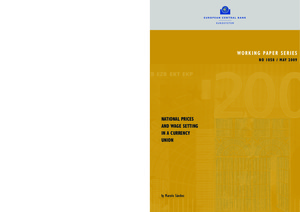National prices and wage setting in a currency union
"Existing work on wage bargaining (as exemplified by Cukierman and Lippi, 2001) typically predicts more aggressive wage setting under monetary union. This insight has not been confirmed by the EMU experience, which has been characterised by wage moderation, thereby eliciting criticism from Pose...
| Main Author: | |
|---|---|
| Institution: | ETUI-European Trade Union Institute |
| Format: | TEXT |
| Language: | English |
| Published: |
Frankfurt am Main
2009
ECB |
| Subjects: | |
| Online Access: | https://www.labourline.org/KENTIKA-19187300124919055829-National-prices-and-wage-setti.htm |
| Summary: | "Existing work on wage bargaining (as exemplified by Cukierman and Lippi, 2001) typically predicts more aggressive wage setting under monetary union. This insight has not been confirmed by the EMU experience, which has been characterised by wage moderation, thereby eliciting criticism from Posen and Gould (2006). The present paper formulates a model where, realistically, trade unions set wages with national prices in mind, deviating from Cukierman and Lippi (2001) who postulate that wages are set having area-wide prices in mind. For reasonable ranges of parameter values (and macroeconomic shocks), simulations show that a monetary union is found to elicit real wages that are broadly comparable to those obtained under monetary autonomy. The confidence bounds around these results are rather wide, in particular including scenarios of wage restraint. The paper also performs welfare comparisons concerning macroeconomic stabilisation in light of structural factors such as country size, the preference for price stability, aggregate demand slopes, labour substitutability across unions, the number of wage-setting institutions and the cross-country distribution of technology and demand shocks." |
|---|---|
| Physical Description: | 59 p. Digital |

